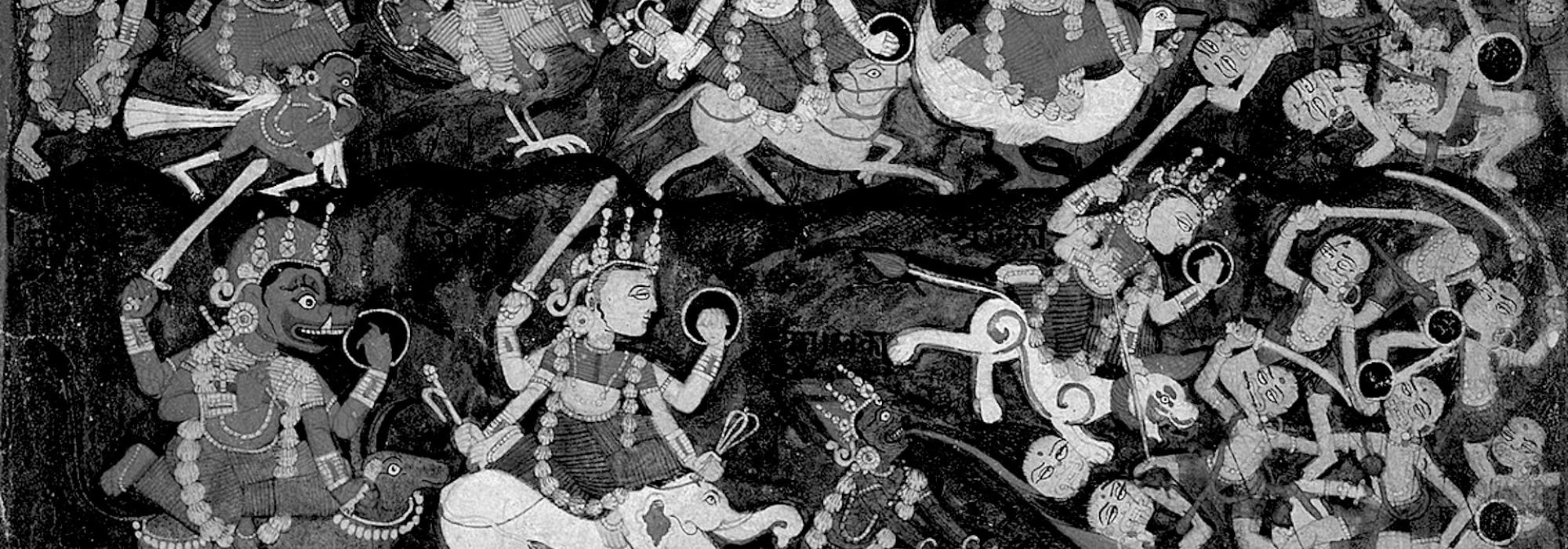The Vishnu Purana declares, “The expert on the Puranas, Veda Vyasa has composed the Purana-samhita that includes ākhyāna upākhyāna gāthā and kalpaśuddhi. He taught it to his disciple, sūta romaharṣaṇa. In turn, sūta romaharṣaṇa taught it to his six disciples, Sumati, Agnivarca Mitrāyu, śāṃsapāyana, akṛtavraṇa and sāvarṇi. Of these, akṛtavraṇa, sāvarṇi, and śāṃsapāyana, who belonged to the kāshyapa gotra became the authors of the samhita-s. The basis of these three samhita-s was romaharṣaṇa’s samhita. The eighteen Puranas were composed n the basis of these four samhita-s. Apart from these, other sages composed the upa-puranas.” (aṃśa 3, chapter 4 Sloka: 15-26).
In this manner, we learn that romaharṣaṇa’s disciples eventually composed the eighteen Puranas. The Vishnupurana is one among them. This is made clear in the Vishnupurana itself in which Vyasa’s father Parashara narrates this account to Maitreya! The śrīmad bhāgavata says[1] that traiyāruṇi, kashyapa, śāṃsapāyana, akṛtavraṇa, sāvarṇi and hārīta studied the fundamental samhita-s from Vyasa’s disciple, romaharṣaṇa. However, the same work says that Vyasa’s son, Shuka-Muni narrated the bhāgavata to the emperor Parikshita. This order of the composition of the Purana-samhita occurs in the Vayupurana and Agnipurana as well. Although names of the disciples slightly vary, the overall theme remains the same. The essence of this discussion is that Veda Vyasa must have composed just the Purana-samhita. Over time, it must have taken the form of the eighteen Puranas at the hands of his disciples and their disciples. Each topic in Vyasa’s original samhita must have been vastly expanded by these disciples and their disciples. If we accept this, the traditional opinion that Vyasa was the author of all the eighteen Puranas seems to have some credence. Vyasa’s disciples and their disciples belonged to various regions and lived in different periods. This also resolves the aforementioned confusion of repetition of the same topics in multiple Puranas. Besides, the raw material for Vyasa’s Purana-samhita was derived from a tradition that already existed in his time. We have already noted how the word Purana occurs in the Atharva Veda and the śatapatha brāhmaṇa. Thus, Vyasa drew from a highly ancient Puranic raw material and composed a seminal samhita in book form. Over the course of time, the eighteen Mahapuranas and Upa-Puranas were composed using Vyasa’s samhita as their base. However, based on this inference, we must not claim that the entire Puranic lore available to us in their present form were all composed by these ancient Rishis. In the medieval period when the Shaiva and Vaishnava sects were engaged in intense sectarian conflict, some unethical adherents composed scores of Slokas and slipped them into the Puranas. In an era when printing had not been invented, making such interpolations was an easy matter. Here we find the answer to the objection that there are many internal conflicts in the Puranic lore.
The prefaces and epilogues to Puranas must have been added much later. Whether they were written by the original Purana authors or were interpolated is difficult to say. From this, we also find a satisfactory answer to the question as to how Vyasa’s father Parashara narrated the Vishnupurana to him. We must deduce the same with regard to the composition of other Puranas as well. This fate has not escaped even our Itihasa-s like the Ramayana and the Mahabharata. Let’s agree that Vyasa himself wrote the Mahabharata. The Mahabharata itself says that Vyasa first narrated it to his disciple romaharṣaṇa. In turn, romaharṣaṇa narrated it to his son ugraśrava who narrated it to Rishis such as śaunaka. However, there is absolutely no reason for Vyasa to mention the name of ugraśrava. Therefore, it is clear that this preface was written by someone else.
And now, it must be said that contemporary scholars who have assigned different periods to the Puranas have erred. In the fourth aṃśa of the Vishnupurana, which narrates the lineage of the emperors of Kaliyuga, the Navanandas are mentioned (Chapter 24). Likewise, other Puranas also contain such historical material. Based on such events of recorded history, such scholars attempt to determine the date of the Puranas on a historical timeline. Traditional scholars reject this method of dating. They aver that the Rishis possessed divine clairvoyance, which enabled them to foresee the entire future events of the Kaliyuga, which they have recorded in the Puranas. Modern scholars reject this entirely. However, it appears that both future events and events of the recorded historical past were interpolated—this seems to be a reasonable conclusion. The overall summary can be stated as follows:
1. The raw material for the Puranas is extremely ancient.
2. Veda Vyasa slightly expanded this Puranic raw material and wrote a samhita.
3. Based on Vyasa’s samhita, his disciples and their disciples composed the eighteen Puranas categorised by topic.
4. It is true that the extant Puranas contain interpolations.
5. Because the Vishnupurana says, “Munis [sages] composed the Upa-puranas,” we can conclude that they were indeed composed by some anonymous Munis. It is incorrect to say that contemporary authors composed the Upa-puranas.
6. Typically, all Puranas mention the eighteen Puranas and the Upa-puranas. Therefore, these prefaces and epilogues were written at a later time and added to the original text.
7. The authors who expanded the Puranas were our ancient Munis and not later day authors.
8. Modern scholars and researchers assign different dates and conclude that Puranas are comparatively of recent antiquity. However, not a single Purana is of recent origin. We can only say that Puranas belong to the post-Mahabharata period.
To be continued














































